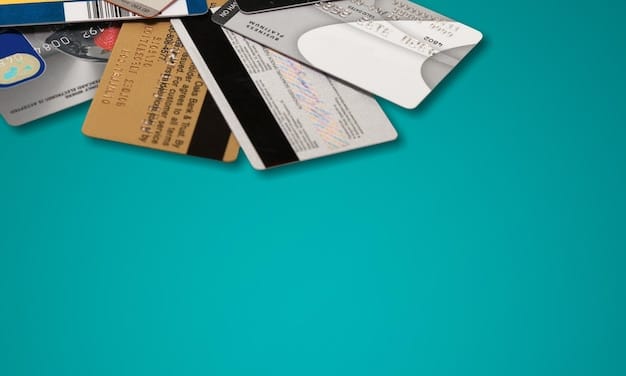Protect Yourself: Identity Theft Guide for Staying Safe Online in 2025

Protecting yourself from identity theft in 2025 requires a proactive approach that includes monitoring your credit reports, securing your online accounts with strong passwords and multi-factor authentication, being cautious of phishing attempts, and keeping your personal information private.
In an increasingly digital world, the threat of identity theft looms larger than ever. This guide provides a comprehensive overview of how to protect yourself from identity theft: a comprehensive guide to staying safe online in 2025, equipping you with the knowledge and tools to navigate the online landscape with confidence.
Understanding the Evolving Threat of Identity Theft
Identity theft is a pervasive crime that continues to evolve with technological advancements. It’s crucial to understand the various forms it can take and the potential consequences it can have on your financial and personal life.
Common Types of Identity Theft
Identity theft isn’t a one-size-fits-all crime. It manifests in various forms, each designed to exploit different vulnerabilities. Here’s a breakdown of some common types:
- Financial Identity Theft: Stealing your financial information (credit card numbers, bank account details) to make unauthorized purchases or open fraudulent accounts.
- Medical Identity Theft: Using your health insurance information to obtain medical care, prescriptions, or file false claims.
- Tax Identity Theft: Filing a fraudulent tax return using your Social Security number to claim a refund.
- Child Identity Theft: Using a child’s Social Security number to open accounts or obtain benefits, often going undetected for years.
The Impact of Identity Theft
The consequences of identity theft can be devastating, extending far beyond financial losses. Beyond the monetary impact, victims often face:
- Damaged Credit Score: Fraudulent activity can negatively impact your credit score, making it difficult to obtain loans, rent an apartment, or even get a job.
- Emotional Distress: Dealing with the aftermath of identity theft can be incredibly stressful, leading to anxiety, depression, and feelings of vulnerability.
- Time-Consuming Resolution: Recovering from identity theft can take months, even years, requiring countless hours of work to correct errors, file reports, and restore your reputation.

Understanding the evolving nature of identity theft and its potential impact is the first step in protecting yourself. By staying informed, you can anticipate new threats and take proactive measures to safeguard your personal information.
Strengthening Your Online Security
In 2025, a strong online presence is essential, but it also presents numerous opportunities for identity thieves. Strengthening your online security is paramount to protecting your personal information.
Creating Strong, Unique Passwords
Passwords are the first line of defense against cyber threats. It’s crucial to create strong, unique passwords for each of your online accounts. Avoid using easily guessable information like:
- Your name, birthday, or address
- Common words or phrases
- Sequential numbers or letters (e.g., 123456, abcdef)
Instead, opt for passwords that are:
- At least 12 characters long
- A combination of uppercase and lowercase letters, numbers, and symbols
- Unique to each website or app
Enabling Multi-Factor Authentication
Multi-factor authentication (MFA) adds an extra layer of security to your accounts by requiring a second form of verification in addition to your password. This prevents unauthorized access even if your password is compromised.
Common MFA methods include:
- One-time codes sent to your phone via SMS or authenticator app
- Biometric authentication such as fingerprint scanning or facial recognition
- Security keys such as a USB device that plugs into your computer
This provides a temporary code that you must enter upon logging in.
Your unique biological data is used to verify your identity.
This device is required to complete the login process.
By implementing strong passwords and MFA, you significantly reduce your risk of falling victim to hacking and account takeovers.
Recognizing and Avoiding Phishing Scams
Phishing scams are a common tactic used by identity thieves to trick individuals into revealing sensitive information. Learning to recognize and avoid these scams is crucial for staying safe online.
Identifying Phishing Attempts
Phishing emails and websites often contain telltale signs that can help you identify them as fraudulent. Be on the lookout for:
- Generic greetings: Phishing emails often start with generic greetings like “Dear Customer” or “Dear User” instead of your name.
- Suspicious links: Hover over links before clicking to check if they lead to a legitimate website. Phishing links often contain typos or unusual characters.
- Urgent requests: Phishing emails often create a sense of urgency, asking you to take immediate action or face negative consequences.
- Poor grammar and spelling: Phishing emails often contain grammatical errors and misspelled words.
Protecting Yourself from Phishing
If you suspect you’ve received a phishing email, take the following steps to protect yourself:
- Don’t click on any links or open any attachments.
- Report the email to the organization that’s being impersonated.
- Delete the email immediately.
By being vigilant and recognizing the warning signs, you can protect yourself from falling victim to phishing scams. Always verify the authenticity of any request for personal information, especially if it comes from an unsolicited source.
It’s impossible to protect yourself from phishing scams completely, but if you take certain precautions, you can make yourself less vulnerable.

Monitoring Your Credit and Financial Accounts
Even with the best preventative measures, your information could still be compromised. Regularly monitoring your credit and financial accounts is crucial for detecting and addressing any fraudulent activity promptly.
Checking Your Credit Reports
You are entitled to a free credit report from each of the three major credit bureaus (Equifax, Experian, and TransUnion) once every 12 months. Reviewing your credit reports regularly allows you to identify any unauthorized accounts, inquiries, or other suspicious activity.
You can obtain your free credit reports by:
- Visiting AnnualCreditReport.com
- Calling 1-877-322-8228
- Contacting each credit bureau directly
This is the authorized website for obtaining free credit reports.
This is the toll-free number to request your free credit reports.
You can contact Equifax, Experian, and TransUnion individually to request your reports.
Monitoring Your Financial Accounts
In addition to monitoring your credit reports, it’s also essential to regularly check your bank and credit card statements for any unauthorized transactions or suspicious activity. Many banks offer online and mobile banking tools that allow you to track your account activity in real-time.
Set up alerts for:
- Large transactions
- Unusual spending patterns
- Login attempts from new devices or locations
You’ll get immediate notification whenever a transaction of a size you specify is made.
You’ll get alerted about any deviations from your regular spending.
When logging in through a new device, the bank will send you a request to confirm via text or email.
By proactively monitoring your credit and financial accounts, you can quickly detect and address any fraudulent activity, minimizing the damage and preventing further losses.
Securing Your Social Security Number
Your Social Security number (SSN) is a critical piece of personal information that can be used to commit identity theft. Protecting your SSN from unauthorized access is paramount.
Limiting Exposure of Your SSN
Avoid sharing your SSN unless absolutely necessary. Be wary of requests for your SSN from unfamiliar sources, especially over the phone or online. Never carry your Social Security card in your wallet or purse.
Limit the use of your Social Security number by:
- Asking why your SSN is needed.
- Avoiding sharing your SSN on unsafe websites
- Don’t give your SSN over the phone unless it’s you initiating it
When asked to provide your SSN, ensure that there is a security measure in place beforehand, as well as asking yourself if you really need to.
Always ensure that the URL starts with “HTTPS” and that there’s a padlock icon displayed.
Scammers are masters of deceit. They can lie and deceive you into giving them your personal and sensitive information in no time.
Protecting Your SSN at Home
Store any documents containing your SSN in a secure location, such as a locked drawer or safe. Shred any documents containing your SSN before discarding them. You want peace of mind knowing that wherever you have your SSN written, it’s completely confidential.
- Purchase a cross-cut shredder
- Use password protection software
- Invest in file cabinets or lockable storage
Cross-cut shredders ensure that your documents are unreadable.
Password protection is a great way to keep your documents with sensitive information out of sight.
Lockable storage is a physical method but can keep your documents in a secured setting
By limiting the exposure of your SSN and taking steps to protect it at home, you can significantly reduce your risk of identity theft.
Staying Informed About New Scams and Threats
The landscape of identity theft is constantly evolving, with new scams and threats emerging regularly. Staying informed about these developments is crucial for protecting yourself.
Subscribing to Security Newsletters and Alerts
Many reputable organizations offer free security newsletters and alerts that provide updates on the latest scams, data breaches, and other cybersecurity threats. Subscribing to these resources can help you stay ahead of the curve and protect yourself from emerging risks.
Some reputable security newsletters include:
- StaySafeOnline
- SANS Institute Newsletters
- KrebsOnSecurity
It provides actionable information every week that helps you stay safe online.
You can receive the latest news about computer security, privacy, and IT via email.
Is Run by reporter Brian Krebs, who provides daily information about fighting cybercrime.
Following Cybersecurity Experts on Social Media
Following cybersecurity experts on social media can provide valuable insights into the latest threats and best practices for staying safe online. Look for experts who share actionable tips and advice in an accessible and easy-to-understand format. You can gain a lot of relevant knowledge and be aware of the latest trends.
Some notable cybersecurity social media accounts include:
- @SwiftOnSecurity
- @GossiTheDog
- @mikko
Providing thoughts on security, privacy, and infosec.
Provides analysis of security and technology.
Provides regular commentary on computer security.
By staying informed about new scams and cybersecurity threats, you can adapt your defenses and minimize your risk of becoming a victim of identity theft.
| Key Point | Brief Description |
|---|---|
| 🛡️ Strong Passwords | Use complex, unique passwords for all online accounts. |
| 🎣 Avoid Phishing | Identify and ignore suspicious emails and links. |
| 💳 Monitor Accounts | Regularly check credit reports and bank statements. |
| 🔒 Secure SSN | Limit exposure and protect your Social Security number. |
FAQ
▼
Identity theft is when someone steals your personal information to commit fraud. This can happen through phishing scams, data breaches, or even stealing physical documents. Thieves might use your info to open credit accounts, file taxes, or get medical care.
▼
You should check your credit report at least once a year. You can get a free credit report from each of the three major credit bureaus annually. It’s also wise to check more frequently if you suspect any fraudulent activity.
▼
If you think you’re a victim, report it immediately to the Federal Trade Commission (FTC). Also, contact the credit bureaus and place a fraud alert on your credit report. Monitor your accounts closely and change your passwords.
▼
A strong password should be at least 12 characters long and include a mix of uppercase and lowercase letters, numbers, and symbols. Avoid using personal information or common words. Use a password manager for unique, secure passwords.
▼
Yes, MFA is highly recommended! It adds an extra layer of security by requiring a second verification method, like a code sent to your phone. This makes it much harder for someone to access your account, even if they have your password.
Conclusion
Protecting yourself from identity theft in 2025 demands a proactive and vigilant approach. By implementing the strategies outlined in this guide, you can significantly reduce your risk and safeguard your personal and financial information in an increasingly connected world.





